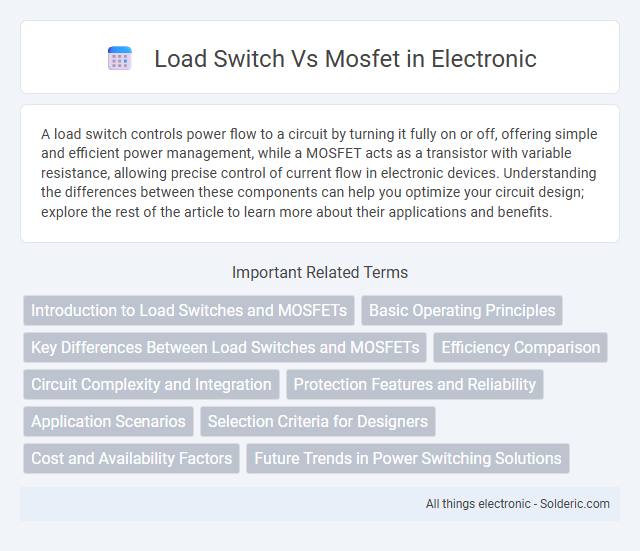A load switch controls power flow to a circuit by turning it fully on or off, offering simple and efficient power management, while a MOSFET acts as a transistor with variable resistance, allowing precise control of current flow in electronic devices. Understanding the differences between these components can help you optimize your circuit design; explore the rest of the article to learn more about their applications and benefits.
Comparison Table
| Feature | Load Switch | MOSFET |
|---|---|---|
| Definition | Integrated semiconductor device designed to control power delivery to a load | Transistor used for switching or amplifying electronic signals |
| Function | Simplifies power management with built-in control and protection features | Acts as a basic switch controlling current flow in circuits |
| Integration | Often includes protection circuits like ESD, current limiting | Requires external components for protection and control |
| Control | Controlled via logic-level input; simplifies load power switching | Gate voltage controls current between drain and source |
| Applications | Power distribution, load switching in portable devices, system power control | General switching applications, amplification, power regulation |
| Complexity | Higher-level device, easier circuit design | Low-level device, requires careful external design |
| Cost | Higher cost due to integrated features | Lower cost, basic transistor component |
Introduction to Load Switches and MOSFETs
Load switches and MOSFETs are essential components in power management, designed to control the flow of electrical current in circuits. A load switch integrates a MOSFET and control circuitry to provide efficient, reliable switching with built-in protections like overcurrent and thermal shutdown. Your choice between a discrete MOSFET and an integrated load switch depends on application complexity, size constraints, and desired safety features.
Basic Operating Principles
A load switch controls power flow to a load by turning on or off, often integrated with protection features like current limiting and thermal shutdown. MOSFETs operate as voltage-controlled switches, where the gate voltage modulates the conductivity between the drain and source terminals, enabling efficient power management. Your choice between a load switch and a standalone MOSFET depends on the required control complexity and protection needs in your electronic circuit design.
Key Differences Between Load Switches and MOSFETs
Load switches integrate MOSFETs with built-in control circuitry designed for efficient power management, providing features like overcurrent protection and soft-start functionality. MOSFETs serve as fundamental semiconductor devices primarily used for switching and amplification without integrated control, requiring external components to manage circuit behavior. Understanding these distinctions helps optimize your power design by selecting load switches for simplified, protected switching or MOSFETs for customizable, discrete control.
Efficiency Comparison
Load switches often provide higher efficiency in low-voltage and low-current applications due to their integrated control circuitry that minimizes power loss. MOSFETs can achieve superior efficiency in high-current environments by offering lower on-resistance (R_DS(on)) and faster switching speeds, which reduce conduction and switching losses. Choosing between a load switch and a MOSFET depends on specific application requirements such as voltage range, current load, and switching frequency to optimize overall power efficiency.
Circuit Complexity and Integration
Load switches offer simpler circuit complexity compared to discrete MOSFETs by integrating essential control features such as gate drivers and protection mechanisms within a single package. This integration reduces PCB space and design challenges, making load switches ideal for compact and efficient power management in your devices. MOSFETs, while flexible, often require additional components and careful layout considerations to achieve similar functionality and reliability.
Protection Features and Reliability
Load switches offer built-in protection features such as overcurrent, overvoltage, and thermal shutdown, enhancing system reliability by preventing damage under fault conditions. MOSFETs require external circuitry to achieve similar protection, potentially increasing design complexity and reducing overall system robustness. Choosing a load switch can simplify your design and improve reliability through integrated safeguards.
Application Scenarios
Load switches are ideal for managing power distribution in portable electronics, battery-powered devices, and power sequencing applications due to their integrated control and protection features. MOSFETs excel in high-speed switching circuits, power amplifiers, and high-efficiency DC-DC converters where precise control of current flow is critical. Your choice depends on whether you need simplified system integration with load switches or the flexibility and efficiency benefits provided by discrete MOSFETs in complex power management designs.
Selection Criteria for Designers
Designers select load switches or MOSFETs based on factors such as on-resistance (R_DS(on)) for efficiency, voltage and current ratings matching the application, and control complexity. Load switches offer integrated protection features like overcurrent and thermal shutdown, making them ideal for simplified power management tasks. Conversely, discrete MOSFETs provide greater flexibility in customization but require external circuitry for full functionality and protection.
Cost and Availability Factors
Load switches typically offer lower cost and easier availability compared to discrete MOSFETs due to integrated features like built-in drivers and protection circuitry, reducing overall component count and design complexity. MOSFETs, while potentially cheaper per unit, may increase total system cost through additional components and more complex PCB layouts necessary for gate driving and protection. In high-volume production, load switches provide a cost-effective and readily available solution, whereas MOSFETs offer design flexibility but may introduce supply chain variability based on specific device selection.
Future Trends in Power Switching Solutions
Future trends in power switching solutions emphasize enhanced efficiency and miniaturization, with load switches integrating advanced MOSFET technology to reduce power loss and improve thermal management. Innovations in wide-bandgap semiconductors like GaN and SiC are driving higher switching speeds and lower conduction losses, shaping the next generation of power management components. Your designs will benefit from these advancements through increased reliability, faster response times, and more compact power switching architectures.
load switch vs mosfet Infographic

 solderic.com
solderic.com